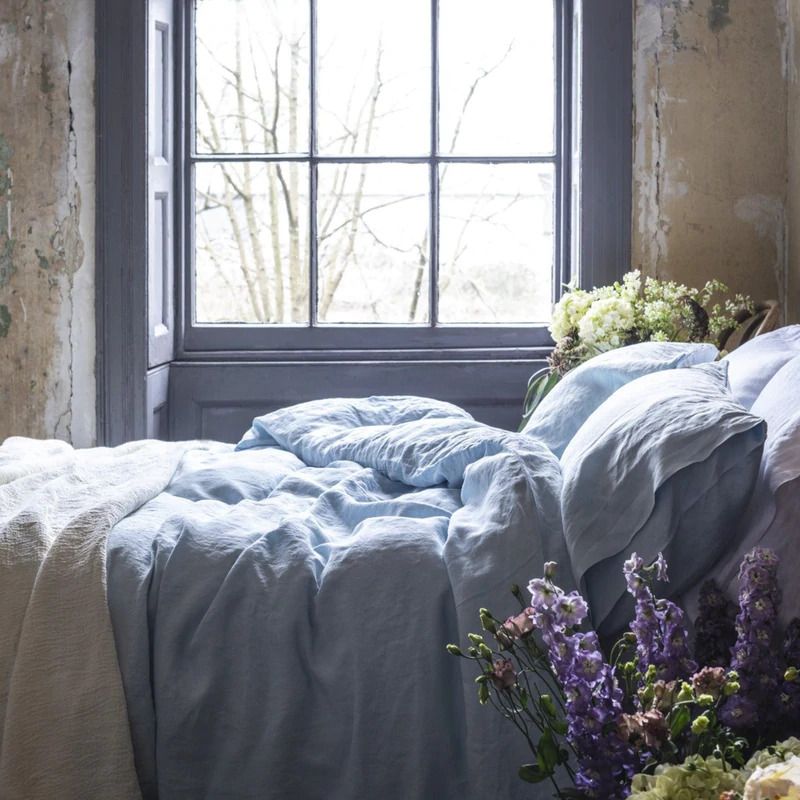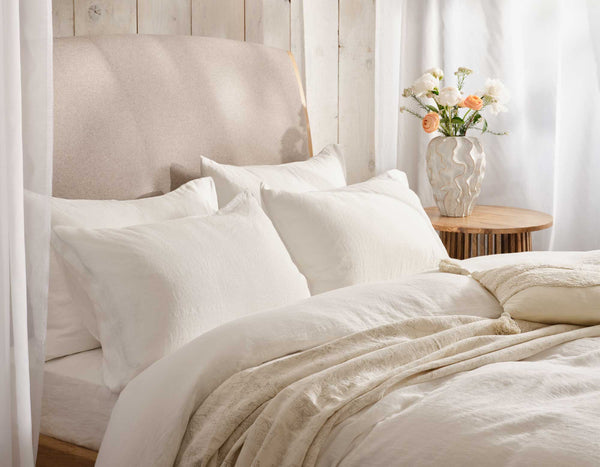Comprehending Linen: The Eco-Friendly Alternative for Comfortable Living
When you think concerning environment-friendly materials, bed linen commonly stands apart for its unique top qualities. This natural fabric, made from the flax plant, offers both comfort and sustainability. Its impressive properties make it an excellent option for cozy weather condition and long-lasting use. What truly establishes bed linen apart from other products? Understanding its beginnings and advantages can change how you check out home fabrics. Let's discover the fascinating world of linen better.
The Beginnings of Bed Linen: From Flax to Fabric

Bed linen, among the earliest fabrics known to humanity, has a fascinating journey that begins with the simple flax plant. You may be stunned to learn that this plant flourishes in great environments, prospering in areas like Europe and components of Asia. As soon as collected, the flax stalks undergo a process called retting, where they're soaked to separate the fibers from the woody parts. After retting, the fibers are brushed and rotated into yarn, prepared for weaving.
When you see bed linen textile, you're observing centuries of workmanship. The weaving procedure changes those spools of thread into the stunning, long lasting fabric you love. Linen has been cherished for its natural look, making it a preferred for whatever from apparel to home fabrics. Next time you touch bed linen, remember its abundant history that connects you to old cultures and their traditional techniques.
The Special Residence of Linen
Among the standout functions of this exceptional textile is its breathability. When you use linen, you'll see exactly how it allows air to distribute, maintaining you cool on warm days. This property makes it a best choice for summer season clothes and sheets.
Linen also boasts outstanding moisture-wicking abilities, drawing sweat far from your skin and permitting it to evaporate swiftly. You won't feel clammy, also in moist conditions. In addition, bed linen is resilient, often ending up being softer and more comfy with each clean, which means it can stand the test of time in your closet.
Another distinct facet is its all-natural texture; the slight abnormalities offer linen a character that improves your design. Plus, it resists wrinkles much better than several various other fabrics, so you can take pleasure in a loosened up yet polished look without much effort. Embrace linen, and you'll appreciate its convenience and one-of-a-kind charm.
Environmental Benefits of Linen
When you select bed linen, you're not simply deciding for a beautiful material; you're likewise supporting lasting manufacturing techniques. Linen's compostable and eco-friendly nature makes it a smart option for the environment. And also, it needs significantly much less water to generate contrasted to various other fabrics, assisting save this valuable source.
Lasting Manufacturing Practices
Although many fabrics have substantial ecological influences, bed linen attracts attention as a result of its lasting production methods. When you choose linen, you're going with a fabric made from the flax plant, which requires marginal water and chemicals. This durable crop can thrive in poor dirt problems, minimizing the requirement for chemical plant foods. Furthermore, the whole flax plant is utilized in production, minimizing waste and advertising source effectiveness.
Linen manufacturing is often much less energy-intensive compared to various other textiles, as it entails natural processes instead than synthetic therapies. By supporting bed linen, you're contributing to an extra sustainable fabric market that focuses on environmentally friendly techniques. Selecting bed linen not only boosts your comfort but likewise aligns your worths with ecological obligation.
Biodegradable and Compostable Material
Bed linen's environment-friendly nature prolongs past its lasting production; it's likewise naturally degradable and compostable, making it a superb selection for environmentally aware consumers. When you choose linen products, you're opting for products that damage down naturally, returning nutrients to the earth. Composting linen can improve dirt, promoting healthy and balanced plant growth.
Low Tide Intake
One of the standout benefits of bed linen is its low tide usage during cultivation. Unlike cotton, which calls for considerable irrigation, linen's flax plant thrives on minimal water, making it an extra lasting option. You'll appreciate recognizing that for every single lots of bed linen generated, significantly less water is required contrasted to numerous other fabrics. This indicates that selecting linen assists save vital freshwater resources, which is critical in today's environment. Additionally, bed linen's natural dry spell resistance enables it to grow in less-than-ideal problems, additionally reducing its ecological effect. By going with bed linen, you're not just buying quality; you're additionally sustaining a textile that advertises responsible water usage and adds to a much healthier world for future generations.
Linen vs. Other Fabrics: A Contrast
When you contrast linen to other textiles, you'll notice its remarkable breathability and comfort, making it best for cozy weather. And also, bed linen sticks out for its resilience and long life, frequently outliving several commonly utilized products. As you consider your selections, the ecological impact of each fabric will likewise play an essential function in your decision.
Breathability and Comfort
Bed linen stands out amongst products for its exceptional ability to permit air blood circulation. Unlike artificial materials, which can trap warm and wetness, bed linen's natural fibers wick away sweat, keeping you dry and trendy.
Cotton is typically praised for its softness, yet it does not match linen's breathability. Even blends could not use the exact same ventilation. If you focus on convenience, especially in summer, bed linen must be your go-to selection. It not just maintains you feeling fresh however also brings a classic sophistication to your wardrobe.
Resilience and Long Life
While many fabrics use varying levels of toughness, linen really succeeds in long life, making it a smart financial investment for your closet. Unlike cotton or synthetic products that may wear out rapidly, bed linen gets stronger with each clean. You'll locate that bed linen's breathable nature also decreases wear from sweat and dampness, which can harm other materials.
Environmental Influence Contrast
Although many materials add to environmental problems, bed linen attracts attention for its green qualities. Unlike cotton, which calls for substantial water sources and pesticides, linen is made from flax, a plant that flourishes on very little water and needs fewer chemicals. This means you can feel good about your option while minimizing your carbon footprint.
When contrasted to synthetic fabrics like polyester, linen's biodegradability shines. While polyester can their explanation take centuries to break down, linen breaks down normally, returning nutrients to the soil.
Selecting linen not only promotes lasting farming methods but likewise supports a much healthier earth. By choosing for bed linen over standard fabrics, you're making an aware decision that profits both your convenience and the setting.
Taking care of Your Bed Linen Textiles
To ensure your bed linen textiles stay in fantastic problem, you'll intend to adhere to some uncomplicated treatment standards. Initially, wash your linen in cold water on a gentle go cycle to stop it from reducing or losing its form. Avoid making use of bleach, as it can harm the fibers. Instead, choose a moderate detergent that's complimentary from extreme chemicals.
When it comes to drying out, air drying out is ideal. Select a low warmth setup and eliminate the products while they're still a little damp to decrease creases if you make use of a clothes dryer. Iron the bed linen while it's still damp for much easier handling, or steam it to maintain it looking crisp.
For storage, keep your bed linen in a trendy, dry location. Stay clear of straight sunshine to avoid fading. With these simple methods, your linen textiles will preserve their beauty and last for many years, making them a sustainable enhancement to your way of life.
Including Bed Linen Into Your Home Design
Looking after your bed linen fabrics not just preserves their top quality yet also opens a world of opportunities for integrating them right into your home style. You can begin small by adding bed linen throw cushions to your sofa, instantaneously elevating the room with appearance and heat. Think about bed linen curtains that filter sunshine beautifully, creating a soft, airy environment in any room.
For a more rustic look, attempt using bed linen tablecloths or joggers during dishes; they add a sophisticated touch and are very easy to tidy. If you're feeling adventurous, mix and match various bed linen link colors and patterns to develop an unique, split impact.
Do not forget regarding linen blankets-- drape one over a chair or your bed for an inviting feel. By thoughtfully incorporating bed linen right into your style, you boost both comfort and style, making your home a calm resort.
The Future of Bed Linen in Lasting Living
As consumers significantly prioritize sustainability, bed linen becomes a frontrunner in eco-friendly textiles. Its manufacturing uses much less water and pesticides contrasted to standard cotton, making it an extra ecologically accountable option. As you look in the direction of a sustainable future, incorporating linen right into your wardrobe and home can substantially minimize your carbon footprint.
Cutting-edge brand names are now concentrating on lasting methods, from utilizing organic flax to carrying out circular economic situation concepts. You'll locate that linen's sturdiness means it lasts longer, reducing the demand for constant substitutes.
In addition, as more people accept minimalist way of lives, bed linen's timeless appeal and adaptability will keep it relevant. By selecting bed linen, you're not just opting for comfort; you're additionally sustaining lasting techniques.
In the upcoming years, the demand for bed linen is anticipated to expand, solidifying its place in a much more eco-conscious world. So, think about making linen a staple in your lasting living trip.
Often Asked Inquiries
Is Bed Linen Appropriate for Individuals With Allergies?
Yes, bed linen's natural fibers are hypoallergenic, making it appropriate for people with allergies. Its breathable nature helps in reducing moisture and bacteria build-up, adding to a much healthier resting atmosphere. You'll likely locate it comfy and safe.
Can Linen Be Colored Quickly?
Yes, you can dye linen conveniently. Its natural fibers soak up dyes well, enabling vivid colors. Simply ensure you utilize the ideal dye kind and adhere to proper techniques to accomplish the desired outcomes without harming the material.
Exactly How Does Linen Contrast in Durability to Cotton?

What Weight of Bed Linen Is Finest for Summer Clothing?
For summertime clothes, light-weight linen around 4 to 5 ounces per backyard is ideal. It maintains you cool, breathable, and comfortable in warm climate (Linenshed). You'll value just how it drapes and actions with you easily

Can Linen Be Utilized for Outdoor Furniture?
Yes, you can use bed linen for outdoor furniture. It's durable and breathable, making it a wonderful selection for cozy weather condition. Just make sure to select a dealt with variation to endure the aspects and maintain its look.
Final thought
Including linen into your life not only boosts your comfort however also sustains an extra lasting future. With its unique residential or commercial properties and minimal ecological influence, linen is a smart choice for your home design and way of living.
Linen's compostable and eco-friendly nature makes it a smart option for the atmosphere. By including bed linen into your home, you're not simply enjoying its convenience and longevity; you're additionally supporting eco-friendly practices and helping produce a healthier world. The Future of Bed Linen in Sustainable Living.
